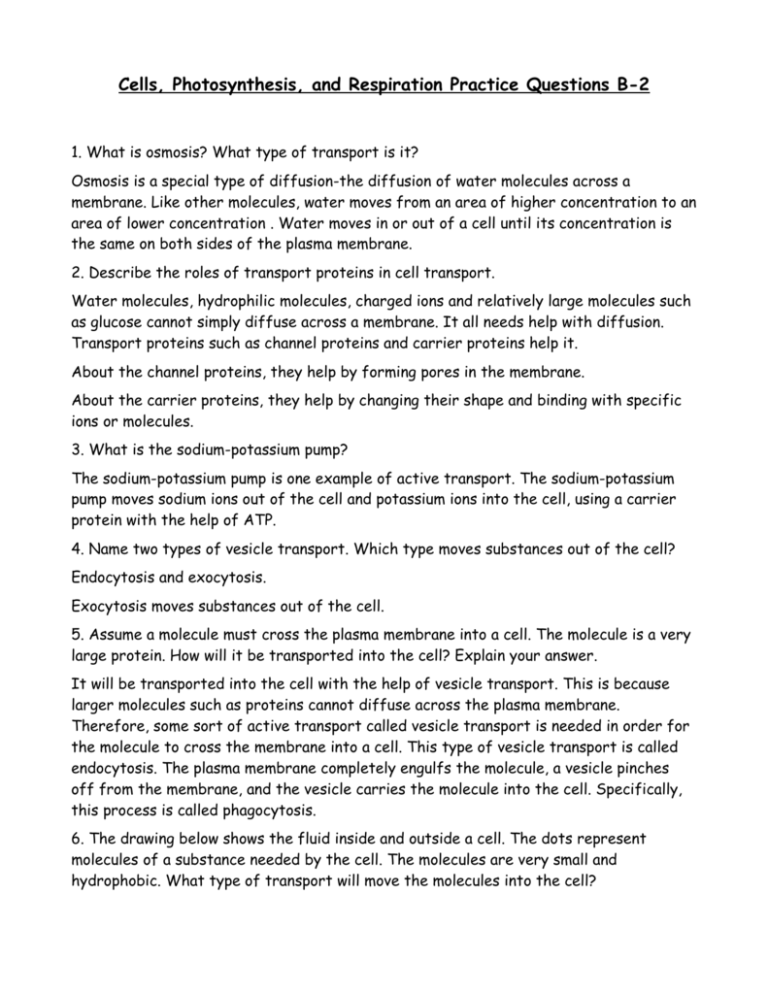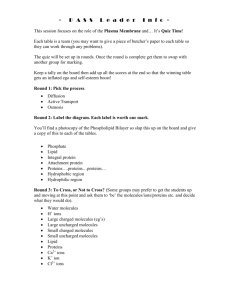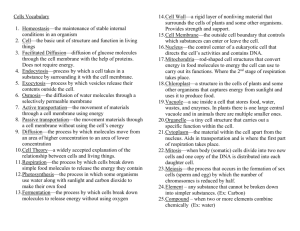Cells, Photosynthesis, and Respiration Practice
advertisement

Cells, Photosynthesis, and Respiration Practice Questions B-2 1. What is osmosis? What type of transport is it? Osmosis is a special type of diffusion-the diffusion of water molecules across a membrane. Like other molecules, water moves from an area of higher concentration to an area of lower concentration . Water moves in or out of a cell until its concentration is the same on both sides of the plasma membrane. 2. Describe the roles of transport proteins in cell transport. Water molecules, hydrophilic molecules, charged ions and relatively large molecules such as glucose cannot simply diffuse across a membrane. It all needs help with diffusion. Transport proteins such as channel proteins and carrier proteins help it. About the channel proteins, they help by forming pores in the membrane. About the carrier proteins, they help by changing their shape and binding with specific ions or molecules. 3. What is the sodium-potassium pump? The sodium-potassium pump is one example of active transport. The sodium-potassium pump moves sodium ions out of the cell and potassium ions into the cell, using a carrier protein with the help of ATP. 4. Name two types of vesicle transport. Which type moves substances out of the cell? Endocytosis and exocytosis. Exocytosis moves substances out of the cell. 5. Assume a molecule must cross the plasma membrane into a cell. The molecule is a very large protein. How will it be transported into the cell? Explain your answer. It will be transported into the cell with the help of vesicle transport. This is because larger molecules such as proteins cannot diffuse across the plasma membrane. Therefore, some sort of active transport called vesicle transport is needed in order for the molecule to cross the membrane into a cell. This type of vesicle transport is called endocytosis. The plasma membrane completely engulfs the molecule, a vesicle pinches off from the membrane, and the vesicle carries the molecule into the cell. Specifically, this process is called phagocytosis. 6. The drawing below shows the fluid inside and outside a cell. The dots represent molecules of a substance needed by the cell. The molecules are very small and hydrophobic. What type of transport will move the molecules into the cell? Simple diffusion. 7. Compare and contrast simple diffusion and facilitated diffusion. For each type of diffusion, give an example of a molecule that is transported that way. Simple diffusion is the movement of a substance across a membrane, due to a difference in concentration, without any help from other molecules. The substance simply moves from the side of the membrane where it is more concentrated to the side where it is less concentrated. For example, very small, hydrophobic molecules, such as molecules of oxygen and carbon dioxide are transported in this way. Facilitated diffusion is the diffusion with the help of transport proteins in the membrane. For example, hydrophilic molecules, charged ions, and relatively large molecules such as glucose are transported in this way. 8. Explain how cell transport helps an organism maintain homeostasis. The cell transport is to move substances into and out of cells. By doing so, cells can keep conditions within normal ranges inside the cells and the organism as a whole. In other words, conditions are always changing both inside and outside the cell, so the cell transport gives constant adjustments to cells for homeostasis.







